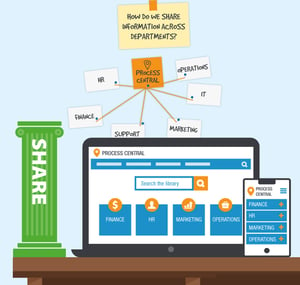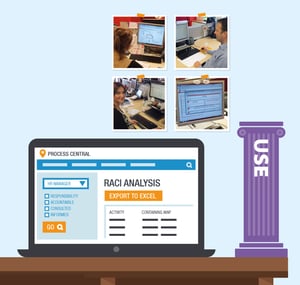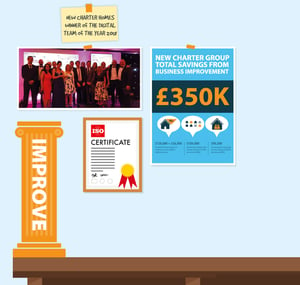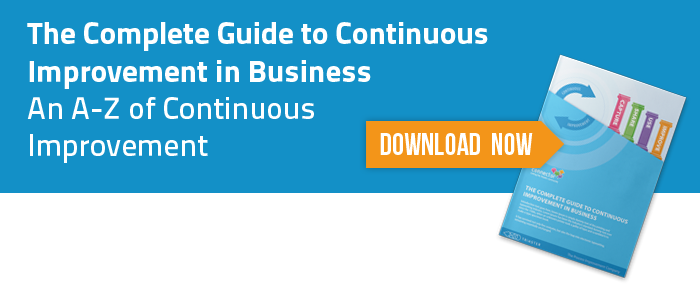
The Complete Guide to Continuous Improvement in Business
Triaster delivers the four pillars of Continuous Improvement. But what is Continuous Improvement? How do the four pillars - Capture, Share, Use and Improve - deliver Continuous Improvement? What about improvement methodologies such as Kaizen, Lean and Six Sigma? How does Continuous Improvement fit with BPM?
The Complete Guide to Continuous Improvement in Business answers all these questions and more.
If you have any further questions, or would just like to speak with us, please call us on +44 (0)207 770 8053 or e-mail us at info@triaster.co.uk – we would love to hear from you.
What is Continuous Improvement?
Understanding the Continuous Improvement Cycle
Kaizen vs Six Sigma vs Lean
Identifying and Eliminating Business Waste
Common Business Improvement Techniques
Developing a Continuous Improvement Culture
Creating a Continuous Improvement Plan
How Other Organisations Approach Business Improvement
How Triaster Can Help to Improve Your Business Performance
Chapter 1 - What is Continuous Improvement?
It is a philosophy that seeks to create gradual and endless change with the objective of incremental business improvement over time.
This philosophy is often represented using a cycle or wheel to illustrate the idea that the process of improvement is never complete - as no business will ever be perfect.
The point of continuous business improvement is not just to implement process change, but to implement an improvement culture - with the focus being most often centered around quality.
W. Edwards Deming's original intent of putting quality first, as part of an organisation's key focus, was that by improving quality, you inadvertently improve everything else too. Quality means efficiency, less risk and more satisfied customers.
What is Continuous Quality Improvement?
Continuous Quality Improvement is different from continuous improvement in the sense that the name is different. The same methodologies and tools exist – Deming wouldn't have seen a distinction between the two.
Quality failure tends to be the result of poor work design, unclear instructions or leadership failure – not the people performing the processes.
The real difference is in organisational focus. Continuous quality improvement is about developing a culture of improvement that puts quality at the heart of an organisation and positions it as the reason why all improvement initiatives take place.
Teamwork is the core mentality behind this improvement philosophy as the employees who are tasked with carrying out the day-to-day processes are often better positioned to offer quality improvement ideas that will mean greater efficiency gains.
Why is Consistent Business Improvement Important?
Business improvement principles were created out of a necessity to make gradual efficiency gains in the workplace. This philosophy advocated a value system that prized quality over quantity and an improvement focus that was on processes instead of people.

By applying a philosophy that was underpinned by constant business analysis and designed to make constant improvement over time, these changes would focus the business on finding wasteful processes and eliminating them.
Not only that, but the by-product of an improvement focus within any organisation would be the creation of a business culture that worked to improve the organisation's way of working constantly by identifying process problems.
This means improving the process, not the person carrying out the process.
There is waste in every organisation; what matters is how you identify it and what you do about it.
Instead of asking for more effort from employees, process improvement seeks to understand a process as it currently is (As Is) and analyses how to improve it going forward (To Be).
Understanding a current process means capturing it and standardising a way of working for that process. When you standardise the way of working, you get every member of the team carrying out the same process, the same way, every time.
Improving the process means that you will improve the performance of every employee using the process; so by focusing on process improvement, you will inadvertently improve employee performance.

Chapter 2 - Understanding the Continuous Improvement Cycle
One of the most widely used improvement models is Plan-Do-Check-Act – named for the various steps that lead to process improvement.
This model is often presented as a wheel or a cycle because of the ongoing nature of the change. The cycle never ends because when the last action is completed (Act), the cycle starts again at the beginning (plan).
Our Model: The 4 Pillars of Continuous Improvement
Our continuous improvement cycle is represented as 4 pillars because each pillar is as important as the others to upholding the process improvement initiative - without one, the rest are useless.
 Capture your processes using process mapping
Capture your processes using process mapping
With Triaster's drag and drop process mapping tool and also the option to capture processes in Microsoft Excel, the mechanism for capturing your processes with the Triaster platform couldn't be easier.
The tricky thing is communicating your processes accurately; Triaster's noun-verb methodology developed alongside our process mapping software really helps with this too.
Learn How >

Share all your processes, policies and documents in one accessible BPM system
The Triaster platform delivers a Process Library as standard. An easy to understand, easy to use, secure website, intelligently presenting all of your processes, policies, forms and guidance documents.
Browse Sample Process Library >
 Use your BPM system to solve your business problem
Use your BPM system to solve your business problem
An easily accessible central source of accurate information, a 'google' for your organisation can be used in so many ways. Through our choice of systems Triaster ensures your Process Library addresses your specific challenges and objectives.
View Triaster Systems >
 Improve your business through effective reporting and analysis
Improve your business through effective reporting and analysis
Process optimisation modelling is enabled with the press of a button. Process simulation, and advanced reporting for business analysis delivers quantifiable return on investment. Improvement is built into the Triaster platform.
Meet the Triaster Platform >
For access to our free e-book which reveals how 8 organisations were able to successfully increase business efficiency, please go here.
Why These Tools are Important
It is also important to understand that a continuous improvement model will be more effective when used in conjunction with a system set up to capture your current process data, analyse your process data and model improvements within a framework that's designed to store and organise processes and assign process responsibility.
These models can work without Business Process Management tools on a small scale; but when processes get more complex, become harder to manager and comprise multiple process users, it's best to organise, analyse and implement change with a BPM system that is already set up to implement a process improvement model.
Our Business Process Management system helps you to capture your processes in a process library, share them with your entire workforce online (hosted in the cloud) and easily access those processes on a daily basis to carry out set tasks (Capture, Share, Use, Improve).
The 'Improve' pillar is the most interesting and probably the most important reason to opt for more than just a standard management system - because improvement requires accurate analysis and process simulation.
By having a Business Process Management system that can model change before it is implemented, you can avoid risk by simulating the potential impact that change will have on your current way of working.
In short, Business Process Management means more simplicity, more efficiency and less risk.
Take a look at this interactive process library example to see how BPM can help you implement a continuous improvement plan.

Chapter 3 - Kaizen vs Six Sigma vs Lean
You might have heard of a few methodologies (such as Kaizen, Lean and Six Sigma). You may also think that these are basically the same thing, but although all three owe their origins to improvement initiatives in the American and Japanese manufacturing industries of the 20th Century, they are all different and they apply to more than just the manufacturing industry.
Developing a Kaizen Culture
Kaizen is a Japanese word meaning 'change for the better' and is also known as 'continuous improvement'. It is a mindset or philosophy rather than being a tool to use.
Kaizen is a belief that everything can be changed and everything can be more efficient. Creating a Kaizen culture entails using personal ingenuity to identify and solve problems in an organisation.
Kaizen is based on a number of principles, namely:
- Good processes bring good results
- Go see for yourself to grasp the current situation
- Speak with data, manage by facts
- Take action to contain and correct root causes of problems
- Work as a team
- Kaizen is everybody’s business
Kaizen's core philosophy is that when everyone is involved in making decisions then this will facilitate innovation and improvement.
Six Sigma
Six Sigma is a set of tools and strategies that were created to limit defects and variability.
It has two project methodologies:
- DMAIC (Define-Measure-Analyse-Improve-Control)
- DMADV (Define-Measure-Analyse-Design-Verify)
These are based on Deming's Plan-Do-Check-Act cycle (as previously mentioned) which has become the foundation for continuous quality improvement.
When using Six Sigma, a team leverages advanced statistical techniques such as pareto charts and root cause analysis to reach quantified value targets.
Lean
Lean is focused on the removal of wastes and it defines waste as anything that fails to add value to the customer.
Lean owes its origins to the ingenuity of the Ford Motor Company more than 100 years ago and has continued to evolve over time as business improvement concepts have also improved over time.
Kaizen vs Six Sigma vs Lean
Kaizen tries to improve the business as a whole by creating a standard way of working, increasing efficiency and eliminating business waste.
Six Sigma is more focused on quality output (the final product). This is facilitated through finding and eliminating the causes of defects.
Lean is all about eliminating waste to increase process speed and quality through the reduction of process waste.
All three have their part to play in developing an effective continuous improvement model and all three can be used (and should be used) depending on the specific problem you need to solve.

Chapter 4 - Identifying and Eliminating Business Waste
In business, there is a huge amount of time spent on activities that provide zero value to the customer. This is estimated to be as much as 95% meaning that only 5% of our activities provide real value to the customer - this is why understanding business waste is important and why, even if you think you're process efficiency is fine, it may be grossly inefficient.
The 7 Wastes of Lean Manufacturing
The 7 Wastes of Lean manufacturing are the activities within an organisation that add zero value. The Lean method identifies these activities so that processes can be improved for the removal of waste.
The 7 Wastes are:
- Transport
- Inventory
- Motion
- Waiting
- Over Processing
- Over Production
- Defects

The 7 Wastes of Service
The 7 Wastes of Service, although derived from Toyota's manufacturing improvement techniques, are a separate set of wastes targeting continuous service improvement.
The intent, like everything in Lean, is to identify and remove waste in the service industry.
The 7 Wastes of Service are:
- Delays
- Duplication
- Unnecessary Movement
- Unclear Communication
- Incorrect Inventory
- Errors
- Opportunity Lost

Chapter-5 - Common Business Improvement Techniques
You know the philosophy (continuous improvement), you know the method (identifying and eliminating waste) but now it's time to look at the techniques used to eliminate waste and continually improve processes in your organisation.
I have listed 4 common improvement techniques below (DMAIC, Value Stream Mapping, PDCA, The 5 Whys) and explained why they are useful as the foundation of a bigger process improvement picture.
DMAIC
DMAIC stands for...
- Define
- Measure
- Analyse
- Improve
- Control
These 4 steps ensure that process improvement initiatives are data-driven, measurable and repeatable. This helps to ensure that you identify the right improvement opportunities, measure the success of any process changes and repeat the process to improve again.
Value Stream Mapping
Value Stream Mapping is the process of visualising the product pipeline as a series of process connections and measuring it in terms of the value that the process step brings to the customer.
The purpose of value stream maps are to visualise delays, restraints and excessive inventory within processes. There are three distinct groupings within the value stream...
- Value Adding – a customer is willing to accept this step as an acceptable cost to them
- Non-value Adding – the customer feels it unfair to assign these costs to them
- Necessary Non-value Adding – costs to the customer are necessary but the customer may still feel unhappy to pay
PDCA
The Deming wheel or Plan-Do-Check-Act is another process improvement cycle similar to DMAIC.
The Plan-Do-Check-Act model is a methodology used to analyse, identify and implement solutions to an existing problem that causes organisations to decline in performance in a particular area.

The 5 Whys
The 5 Whys Is a technique that was developed to try and get to the root cause of a problem; not just to identify the problem symptoms.
The 5 Whys are important to finding bottlenecks and flawed processes within an organisation.
The number of Whys can vary but 5 is usually the right number to get to the root of the problem.
Here is an example...
The customer is unhappy
1. Why is the customer unhappy?
The customer is unhappy because no one responded to her support request
2. Why didn’t anyone respond to her support request?
No one responded to her support request because she posted it on Twitter
3. Why didn’t anyone respond to her tweet?
No one responded to her tweet because Alice is on vacation
4. Why does Alice’s vacation mean no one responded to the tweet?
Because Alice is the only one who responds to tweets and she doesn’t have a backup
5. Why doesn’t Alice have a backup?
Because we never thought about it before


Chapter 6 - Developing a Continuous Improvement Culture
Changing Culture and Improving Performance
Getting the right improvement technique is an important part of increasing business performance; but another part, that is just as important, is understanding how to create a culture of continuous improvement and get employees to buy in to any change initiative.
Culture fails to change when there is too much focus on the implementation of systems and methodologies without including the key stakeholders in the conversation. Over the years, our customers have informed us that in order to achieve the adoption of a new culture there was a definite need for three ingredients to be present...
- Employee Buy-in
- Senior Management Commitment
- Ongoing Communication

Creating a Business Improvement Team
Konosuke Matsushita, the founder of Panasonic, once said (regarding the American business model):
"with your bosses doing the thinking, while the workers wield the screwdrivers, you're convinced deep down that this is the way to run a business...business, we know, is now so complex and difficult, the survival of the firm so hazardous in an environment increasingly unpredictable, competitive and fraught with danger, that its continued existence depends on the mobilisation of every ounce of intelligence."
What was Matsushita talking about?
Employees are the gold mine of organisational efficiency – but you have to mine to get to the good stuff. We now know that management must include the process owner (the employee carrying out the task) in the improvement conversation. They are the ones responsible for the task so they will know the best ways to improve it – you just need a plan focused on getting the gold out of them. If employees are involved in the conversation, they are more inclined to be committed to the plan and your project is more likely to succeed.


Chapter 7 - Creating a Continuous Improvement Plan
Developing the Plan
Cultural change is difficult and requires communication and commitment to the task of business improvement; however, as I have also mentioned, this in isolation is not enough to achieve increased efficiency in your organisation.
Any improvement project must include:
- Technical Change - implementation of a Business Process Management system
- Cultural Change – getting managers, stakeholders involved and keeping them involved
Once a technical change is decided on and everyone is on board with the change, then you can implement these important Lean process steps.
10 Continuous Improvement Process Steps
- Understand How Your Business Works - inefficiency is a byproduct of not understanding how your organisation functions. Capture your current processes to identify inefficiencies
- Focus on the Outputs - What is your work actually producing?
- Get the Input of Employees - they are the ones who know the process and will carry it out. They will also have great input as to how to improve the process
- Look at the Handover Points - When one department hands over to the other is this seamless? Is one giving the other what they need in the form they need it?
- Look for Bottlenecks - Find the least efficient processes in the organisation and clean them up
- Involve the Person Who Owns the Process - this is the person who will need to carry out the task so they will need to have a say in any process improvement initiatives
- Establish a Best Practice - this ensures the continuation of efficiency gains
- Capture Key Data - To know your processes is to understand how to improve them
- Model Potential Improvements - modelling change before implementation is crucial for ensuring change doesn't impact negatively on your organisation
- Analyse Your Organisation for Efficiency Opportunities - this is critical for ongoing process improvement

Of course there are all sorts of models, cycles and techniques out there that will help an organisation to improve, but to change culture and reach data-driven insights that can capture waste as a metric, you will most likely need a system capable of managing and organising thousands of process maps and visualising full RACI, risk and ROI data.


Chapter 8 - How Other Organisations Approach Business Improvement
Developing your own plan from the 10 steps listed in the previous section will help you structure your change from start to finish. The actions below demonstrate how real businesses have been successful in approaching their own improvement initiatives. After analysing 20 companies and their business improvement efforts, there are 9 actions that stand out as important for organisational success...
- Creating an Operational Excellence Group
- Develop an action plan
- Stakeholder engagement
- A single management system in the business that is useful, usable and becomes used
- Launch Events and Training will help create a culture that accepts the change
- An Easy to Understand Continuous Improvement Methodology
- Capture the current state of affairs in the organisation
- Establish a consistent best practice
- Make any Large Scale Changes Sharable and Accessible
If you would like to preview the system that helps our customers achieve all 9 of these steps then please go here.
Continuous Improvement Examples in the Workplace
Let's go deeper and look at an organisation that used Triaster's BPM system to save £350k per annum.
New Charter Homes came to Triaster because they needed to address three initial problems:
- The organisation faced a 15% reduction in revenue by 2019/2020
- A restructure was necessary, resulting in a lack of resources and being unable to deliver on paper-based processes
- The Service Improvement team wanted to improve tenant/customer satisfaction
The Service Improvement Team at New Charter Homes made the decision to map out the end-to-end processes of the entire tenancy lifecycle – a rather large and detailed undertaking.
In order to increase business performance, New Charter's Service Improvement Manager and her team decided to purchase Triaster's Business Process Management software.

Below you can see a snapshot of the efforts that enabled them to implement a successful business process improvement project:
- The Service Improvement team started with a process capture workshop, inviting all the key stakeholders for the Keys-to-Keys process
- The team went on job-shadowing excursions to ensure that the processes that were mapped were actually a true representation of what was carried out on the job
- As well as capturing the processes, the data was captured too. Using a bespoke properties file developed by Triaster, the team was able to automatically calculate the cost of every activity
- The team then mapped the AS-IS (current state) of the entire keys-to-keys process (about 280 process maps), which exhibited great potential for process improvement
- Finally, New Charter's Service Improvement team completed the modelling of the TO-BE processes and investigated ways of replacing paper-based processes with mobile applications
- These mobile solutions were then specifically designed to address the New Charter Group's key challenges

Chapter 9 - How Triaster Can Help to Improve Your Business Performance
By implementing Triaster's Busines Process Management and Improvement Platform, the New Charter Group were not only able to save £350k per annum but won a the Digital Technology Leader Award in 2017.
You can download the full New Charter case study here and to look at information and pricing on Triaster's BPM system, please go here.





